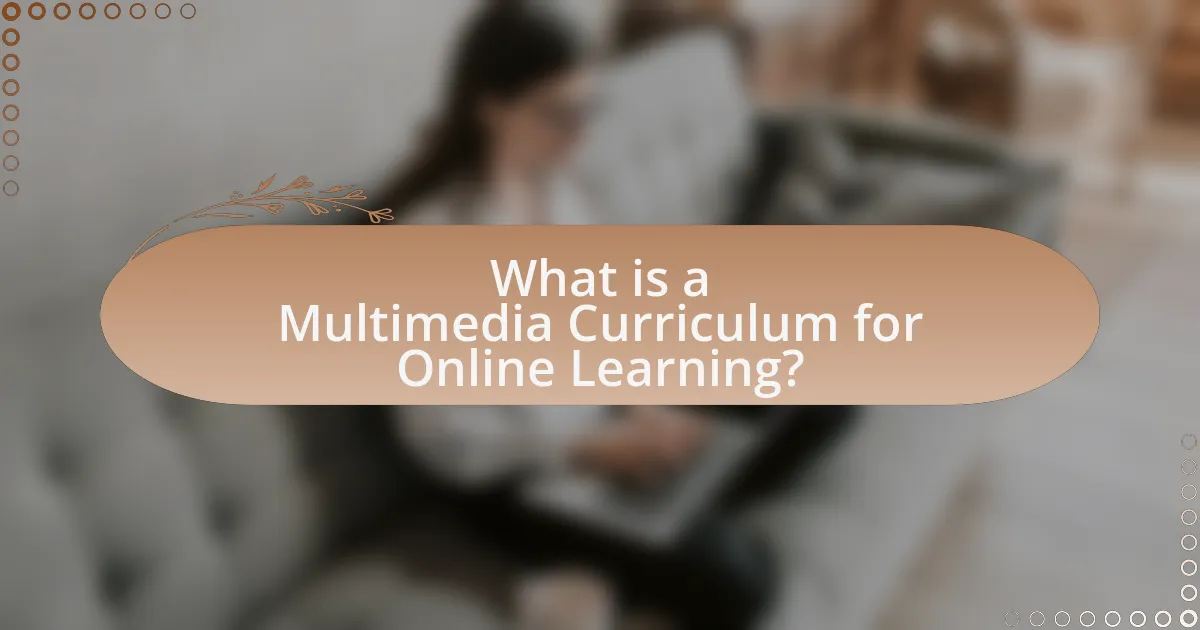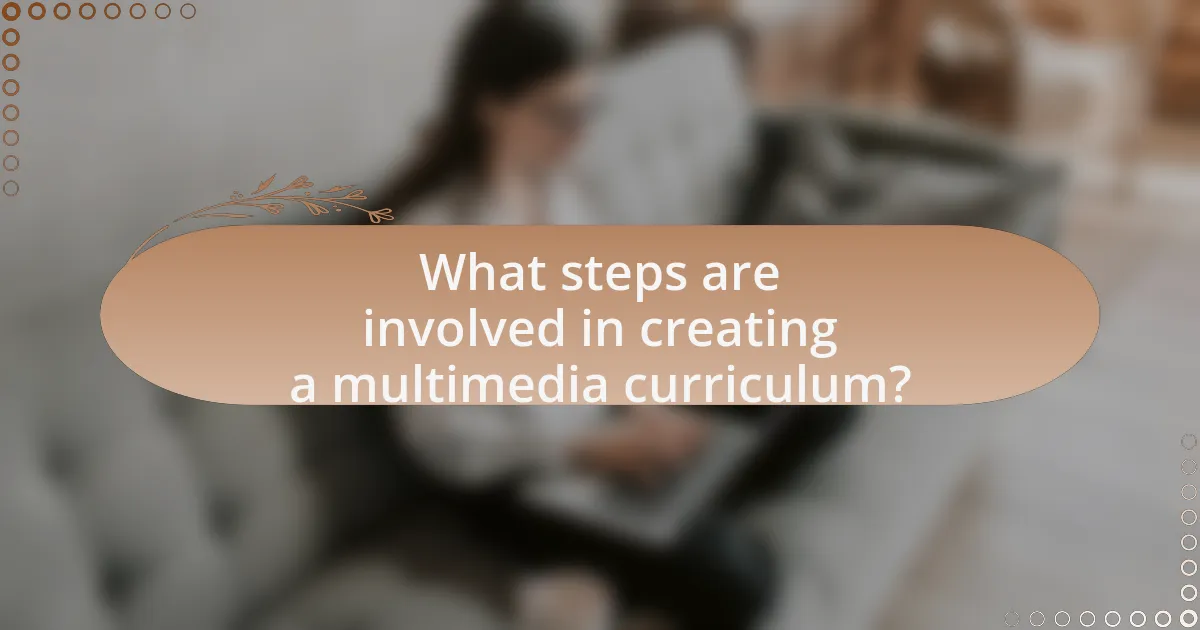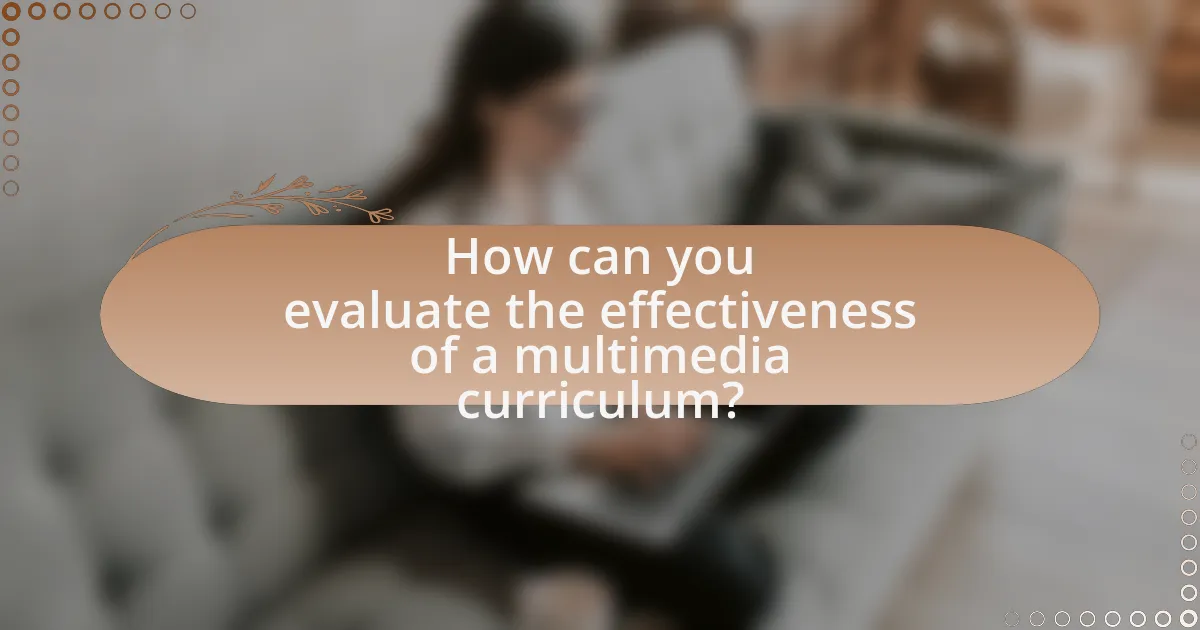A Multimedia Curriculum for Online Learning is an educational framework that integrates various media types—such as text, audio, video, and interactive elements—to enhance the learning experience. This article outlines the benefits of multimedia in online education, including improved engagement, retention, and understanding of complex concepts. Key elements of a multimedia curriculum, strategies for creating and assessing it, and the importance of catering to diverse learning styles are discussed. Additionally, the article addresses common challenges in implementation and offers best practices for ensuring accessibility and enhancing user experience in online learning environments.

What is a Multimedia Curriculum for Online Learning?
A Multimedia Curriculum for Online Learning is an educational framework that integrates various forms of media, such as text, audio, video, and interactive elements, to enhance the learning experience. This approach leverages diverse content types to cater to different learning styles and improve engagement, retention, and understanding of the material. Research indicates that multimedia learning can lead to better educational outcomes; for instance, the Cognitive Theory of Multimedia Learning, proposed by Richard Mayer, suggests that people learn more deeply from words and pictures than from words alone. This theory is supported by empirical studies demonstrating that multimedia resources can significantly enhance comprehension and retention in online education settings.
How does a multimedia curriculum enhance online learning experiences?
A multimedia curriculum enhances online learning experiences by integrating various forms of content, such as text, audio, video, and interactive elements, which cater to diverse learning styles. This approach increases engagement and retention, as studies show that learners retain 65% of information when it is presented in a multimedia format compared to only 10% when presented in text alone. Furthermore, multimedia elements can facilitate deeper understanding by providing visual context and real-world applications, making complex concepts more accessible. For instance, research published in the Journal of Educational Psychology indicates that students who learn through multimedia resources perform better on assessments than those who rely solely on traditional methods.
What are the key elements of a multimedia curriculum?
The key elements of a multimedia curriculum include diverse content formats, interactive components, clear learning objectives, and assessment strategies. Diverse content formats, such as videos, audio, text, and graphics, cater to different learning styles and enhance engagement. Interactive components, like quizzes and discussion forums, promote active participation and deeper understanding. Clear learning objectives guide the curriculum structure and ensure that learners know what to expect. Assessment strategies, including formative and summative evaluations, measure learner progress and the effectiveness of the curriculum. These elements collectively create an effective multimedia curriculum that supports online learning.
How do different media types contribute to learning outcomes?
Different media types enhance learning outcomes by catering to diverse learning styles and improving engagement. For instance, visual media such as videos and infographics can simplify complex concepts, making them more accessible and memorable, as supported by research from Mayer (2009) which indicates that multimedia presentations can lead to better retention of information. Additionally, auditory media, like podcasts and lectures, can reinforce learning through repetition and auditory processing, which is effective for auditory learners. Interactive media, such as simulations and quizzes, actively involve learners, promoting deeper understanding and application of knowledge, as shown in studies by Moreno and Mayer (2000) that highlight the benefits of interactivity in learning. Overall, the integration of various media types in a multimedia curriculum can significantly enhance the effectiveness of online learning by addressing different preferences and improving overall educational outcomes.
Why is it important to integrate multimedia in online education?
Integrating multimedia in online education is important because it enhances engagement and improves learning outcomes. Research indicates that multimedia elements, such as videos, animations, and interactive simulations, cater to various learning styles and help maintain student interest. For instance, a study published in the Journal of Educational Psychology found that students who learned through multimedia resources scored significantly higher on assessments compared to those who used traditional text-based materials. This demonstrates that multimedia not only makes learning more enjoyable but also facilitates better retention and understanding of complex concepts.
What advantages does multimedia offer over traditional teaching methods?
Multimedia offers several advantages over traditional teaching methods, primarily by enhancing engagement and improving retention of information. Studies indicate that incorporating multimedia elements, such as videos, animations, and interactive content, can increase student motivation and participation, leading to a more dynamic learning environment. For instance, research published in the Journal of Educational Psychology found that students who learned through multimedia resources scored significantly higher on retention tests compared to those who received traditional instruction. Additionally, multimedia caters to various learning styles, allowing visual, auditory, and kinesthetic learners to grasp concepts more effectively, thereby fostering a more inclusive educational experience.
How does multimedia cater to diverse learning styles?
Multimedia caters to diverse learning styles by integrating various formats such as text, audio, video, and interactive elements, which engage different sensory modalities. For instance, visual learners benefit from graphics and videos, auditory learners gain from podcasts and spoken content, while kinesthetic learners engage with interactive simulations and hands-on activities. Research by Fleming and Mills (1992) identifies four primary learning styles: visual, auditory, reading/writing, and kinesthetic, demonstrating that multimedia can effectively address these preferences. By providing multiple avenues for information absorption, multimedia enhances comprehension and retention across a broader audience.

What steps are involved in creating a multimedia curriculum?
Creating a multimedia curriculum involves several key steps: defining learning objectives, selecting appropriate multimedia tools, designing content, integrating assessments, and evaluating effectiveness.
First, educators must clearly define the learning objectives to ensure that the curriculum aligns with educational goals. Next, selecting multimedia tools, such as videos, interactive simulations, and podcasts, enhances engagement and caters to different learning styles. Designing content involves creating or curating materials that are visually appealing and informative, ensuring that they support the defined objectives.
Integrating assessments throughout the curriculum allows for measuring student understanding and progress, while evaluating effectiveness involves gathering feedback and analyzing outcomes to make necessary adjustments. These steps collectively contribute to a comprehensive multimedia curriculum that enhances online learning experiences.
How do you assess the needs of your learners?
To assess the needs of learners, I utilize a combination of surveys, interviews, and formative assessments. Surveys gather quantitative data on learners’ backgrounds, preferences, and learning styles, while interviews provide qualitative insights into their specific challenges and goals. Formative assessments, such as quizzes and reflective journals, help identify knowledge gaps and areas requiring additional support. Research by Knowles (1980) on adult learning principles emphasizes the importance of understanding learners’ motivations and experiences, which reinforces the effectiveness of these assessment methods in tailoring a multimedia curriculum for online learning.
What tools can be used for learner assessment?
Various tools can be used for learner assessment, including online quizzes, surveys, learning management systems (LMS), and e-portfolios. Online quizzes, such as those created with platforms like Kahoot or Quizlet, allow for immediate feedback and engagement. Surveys can gather learner insights and assess understanding through tools like Google Forms or SurveyMonkey. Learning management systems, such as Moodle or Canvas, provide integrated assessment features, tracking learner progress and performance. E-portfolios enable learners to showcase their work and reflect on their learning journey, facilitating a comprehensive assessment of skills and knowledge. These tools are widely recognized for their effectiveness in evaluating learner outcomes in online education settings.
How do you analyze the results of learner assessments?
To analyze the results of learner assessments, educators should first collect quantitative data, such as scores and completion rates, alongside qualitative feedback from learners. This data can be analyzed using statistical methods to identify trends, strengths, and areas for improvement in the curriculum. For instance, a study by the National Center for Education Statistics found that analyzing assessment data can reveal significant insights into learner performance and engagement, allowing for targeted instructional adjustments. By triangulating both quantitative and qualitative data, educators can gain a comprehensive understanding of learner outcomes and enhance the effectiveness of the multimedia curriculum.
What types of multimedia can be included in the curriculum?
Various types of multimedia can be included in the curriculum, such as videos, audio recordings, interactive simulations, infographics, and digital presentations. Videos can enhance understanding by providing visual context, while audio recordings can support auditory learning. Interactive simulations allow students to engage with content actively, fostering deeper comprehension. Infographics present complex information in a visually appealing format, making it easier to digest. Digital presentations can facilitate organized delivery of information, enhancing engagement and retention. These multimedia elements have been shown to improve learning outcomes by catering to diverse learning styles and increasing student motivation.
How can videos be effectively utilized in online courses?
Videos can be effectively utilized in online courses by enhancing engagement, facilitating understanding, and providing diverse learning experiences. Incorporating videos allows instructors to present complex concepts visually, which can improve retention rates; studies show that learners retain 65% of information when it is paired with relevant visuals, compared to only 10% when presented through text alone. Additionally, videos can cater to different learning styles, such as auditory and visual learners, making the content more accessible. By using a mix of instructional videos, demonstrations, and interactive elements, educators can create a dynamic learning environment that encourages active participation and deeper comprehension.
What role do interactive elements play in engagement?
Interactive elements significantly enhance engagement by actively involving learners in the educational process. These elements, such as quizzes, polls, and discussion forums, foster a sense of participation and ownership over learning, which can lead to improved retention and understanding of the material. Research indicates that courses incorporating interactive components can increase learner engagement by up to 60%, as they encourage immediate feedback and facilitate social interaction among peers. This active participation not only maintains attention but also promotes deeper cognitive processing, making the learning experience more effective.

How can you evaluate the effectiveness of a multimedia curriculum?
To evaluate the effectiveness of a multimedia curriculum, one can utilize a combination of quantitative and qualitative assessment methods. Quantitative methods include pre- and post-assessments to measure knowledge gains, tracking student engagement metrics such as completion rates and time spent on tasks, and analyzing test scores to determine learning outcomes. Qualitative methods involve gathering student feedback through surveys and interviews to assess their perceptions of the curriculum’s relevance and engagement level. Research indicates that multimedia elements can enhance learning when they align with educational objectives, as shown in studies like Mayer’s Cognitive Theory of Multimedia Learning, which emphasizes the importance of coherence and modality in instructional design.
What metrics should be used to measure success?
To measure success in creating a multimedia curriculum for online learning, key metrics include learner engagement, completion rates, assessment scores, and learner satisfaction. Learner engagement can be quantified through participation in discussions, video views, and interaction with multimedia content. Completion rates indicate the percentage of learners who finish the course, reflecting the curriculum’s effectiveness. Assessment scores provide insight into knowledge retention and understanding, while learner satisfaction can be gauged through surveys and feedback forms. These metrics collectively offer a comprehensive view of the curriculum’s impact and effectiveness in achieving educational goals.
How can learner feedback be incorporated into evaluations?
Learner feedback can be incorporated into evaluations by systematically collecting and analyzing student responses to assess their understanding and engagement. This process involves using surveys, quizzes, and reflective journals to gather insights on the learning experience. For instance, a study by Hattie and Timperley (2007) emphasizes that feedback is crucial for enhancing student performance, as it provides specific information on what learners understand and where they struggle. By integrating this feedback into evaluations, educators can adjust instructional strategies and curriculum design to better meet learner needs, ultimately improving educational outcomes.
What tools are available for tracking learner progress?
Tools available for tracking learner progress include Learning Management Systems (LMS) such as Moodle, Canvas, and Blackboard, which provide analytics on student engagement and performance. These platforms allow educators to monitor assignments, quizzes, and overall course completion rates. Additionally, tools like Google Classroom and Edmodo offer features for tracking student submissions and feedback. Research indicates that effective use of these tools can enhance educational outcomes by providing timely insights into learner performance, enabling targeted interventions.
What are common challenges in creating a multimedia curriculum?
Common challenges in creating a multimedia curriculum include technological limitations, content integration, and accessibility issues. Technological limitations arise when educators lack the necessary tools or skills to effectively utilize multimedia resources, which can hinder the curriculum’s implementation. Content integration challenges occur when aligning multimedia elements with learning objectives, making it difficult to create a cohesive educational experience. Accessibility issues often arise when multimedia content is not designed to accommodate diverse learning needs, potentially excluding students with disabilities. These challenges are supported by research indicating that 30% of educators report insufficient training in multimedia tools, and studies show that 20% of online content fails to meet accessibility standards.
How can technical issues be addressed during implementation?
Technical issues during implementation can be addressed by conducting thorough pre-implementation testing and establishing a responsive support system. Pre-implementation testing allows for the identification of potential technical problems before they affect users, ensuring that software and hardware are compatible and functioning as intended. A responsive support system, including help desks and troubleshooting guides, provides immediate assistance to users facing technical difficulties, thereby minimizing disruptions. Research indicates that organizations that implement robust testing and support mechanisms experience a 30% reduction in technical issues during deployment, highlighting the effectiveness of these strategies.
What strategies can be employed to overcome learner resistance?
To overcome learner resistance, educators can employ strategies such as fostering a supportive learning environment, incorporating learner feedback, and utilizing engaging multimedia resources. Creating a supportive environment encourages open communication and trust, which can reduce resistance. Actively seeking and integrating learner feedback into the curriculum allows students to feel valued and invested in their learning process. Additionally, using engaging multimedia resources, such as videos and interactive content, can capture learners’ attention and enhance motivation, making the learning experience more appealing. Research indicates that when learners are actively involved and their preferences are considered, resistance decreases significantly, leading to improved educational outcomes.
What best practices should be followed when designing a multimedia curriculum?
When designing a multimedia curriculum, best practices include aligning content with learning objectives, incorporating diverse media formats, and ensuring accessibility for all learners. Aligning content with clear learning objectives ensures that multimedia elements serve specific educational goals, enhancing the effectiveness of the curriculum. Incorporating diverse media formats, such as videos, interactive simulations, and infographics, caters to different learning styles and keeps students engaged. Ensuring accessibility involves providing alternative formats and considering the needs of learners with disabilities, which is essential for inclusivity and compliance with educational standards. These practices are supported by research indicating that multimedia learning can improve retention and understanding when designed thoughtfully.
How can you ensure accessibility for all learners?
To ensure accessibility for all learners, implement universal design principles in your multimedia curriculum. Universal design involves creating educational materials that are usable by all individuals, regardless of their abilities or disabilities. For example, providing captions for videos, using screen reader-compatible formats, and ensuring that all content is navigable via keyboard can significantly enhance accessibility. Research indicates that 15% of the global population experiences some form of disability, highlighting the necessity of inclusive practices in education. By adhering to these principles, you can create a learning environment that accommodates diverse needs and promotes equal opportunities for all learners.
What tips can enhance the overall user experience in online learning?
To enhance the overall user experience in online learning, it is essential to incorporate interactive elements such as quizzes, discussions, and multimedia content. Research indicates that interactive learning can increase engagement and retention rates by up to 60%, as highlighted in a study by the University of Colorado Boulder. Additionally, providing clear navigation and user-friendly interfaces significantly improves accessibility, allowing learners to focus on content rather than technical difficulties. Implementing regular feedback mechanisms, such as surveys and assessments, also fosters a sense of community and encourages continuous improvement in the learning process.